|
Ruins of Edo Castle

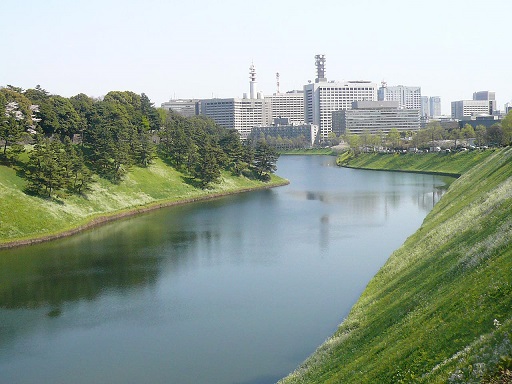
|
Edo Castle was the capital of the "Edo Bakufu", the central government of Japan, and where "Shogun"s lived in the Edo Age
(1603 - 1868)
.
Originally, Edo Castle was built in 1457 by OTA Dokan
(1432 - 1486)
.
When TOKUGAWA Ieyasu
(1543 - 1616)
was moved to Edo in 1590, according to the assignment by TOYOTOMI Hideyoshi
(1537 - 1598)
, Edo castle was abandoned and fell into disrepair.
From the first to the third "Shogun", TOKUGAWA Ieyasu, TOKUGAWA Hideyori
(1579 - 1632)
and TOKUGAWA Iemitsu
(1604 - 1651)
redeveloped Edo Castle until 1648. In 1868, Edo Castle became the Imperial Palace when the Edo Age finished.
The ruins of Edo castle are located at Marunouchi in Tokyo, just west of Tokyo Station.
The east end of Edo Castle was at Tokyo Station, the north end is Suidobashi Station, the west end is Yotsuya Station and the south end is close to Shinbashi Station. Edo Castle was one of the biggest castles in the world.
The ruins of Edo Castle are now preserved as the Imperial Palace. The East Garden of the Imperial Palace used to be the main bailey and is now open to the public.
The ruins of EDO castle will be introduced with the following chapters:
|
|
|
|
"Ote-Mon" Gate to the Main Bailey
The main entrance of Edo Castle was the "Ote-Mon" Gate. The "Ote-Mon" Gate is now the main gate of the East Garden, which is located at the north of Palace Hotel and to the east of Otemachi Station of Tokyo Metro.
The "Ote-Mon" Gate is located across the inner moat.
The "Ote-mon" Gate was rebuilt in 1963. The "Ote-Mon" Gate consists of two gates. One is a smaller gate, called "Korai-Mon" gate and the other one is "Yagura-Mon" gate. Between these two gates, there is a square-shaped area of land. This style of gate is called "Masukata-Mon" style and provides the strongest protection.
|
|
The "Ote-Mon" Gate, the Main Gate of the Edo Castle
|
|
|
|
|
After passing through the "Ote-Mon" Gate, there is a security gate to enter The East Garden of the Imperial Palace. The gate is open from 9:00AM to 4:30PM from March 1st to Oct. 30th, 9:00AM to 5:00PM from Nov. 1st to the end of February. During summer season, from April 15 to Aug. 31th, the gate is open from 9:00AM to 5:00PM. Monday is closed, except national holidays. If Monday is a national holiday, Tuesday and Friday are closed.
The "Ote-Mon" Gate is located at the third bailey. "Sannomaru Shozokan" is located on your right. "Sannomaru Shozokan" is the museum which Imperial Household properties are displayed.
In the third bailey, only the approach to the main bailey is permitted to walk.
You will see the site of the "Ote Sanno Mon" Gate.
The "Ote Sanno Mon" Gate is the entrance to the second bailey.
In the second bailey, the original guard houses remain.
One is "Doshin" Guard House, which is located behind the "Ote Sanno Mon" Gate.
Another one is the "Hyakunin" Guard House to the left of the "Ote Sanno Mon" Gate.
|
"Hyakunin" Guard House

|
|
"Doshin" Guard House
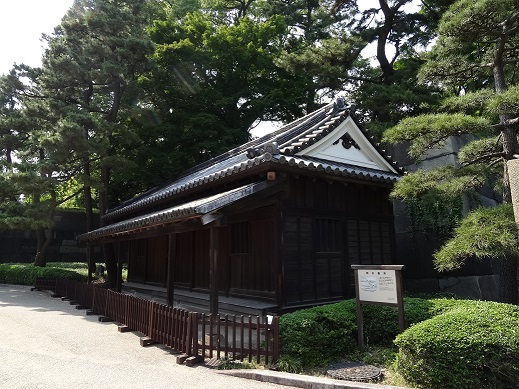
|
|
The "Hyakunin" Guard House means a guard house where a hundred guards can stay.
Actually, four hundred guards stayed in this guard house in the Edo Age.
To the right side of the "Hyakunin" Guard House, the site of the "Nakanomon" Gate is located.
The "Nakanomon" Gate is the entrance of the main bailey.
Today, only stone foundations of the gate building remain.
However, you will see how big such stone foundations are.
"Oh-Bandokoro", the Large Guard House, remains behind the "Nakanomon" Gate.
After passing the "Nakanomon" Gate, you will go up the slope and finally you will reach the main bailey.
In the Edo Age, "Chu-Jyaku-Mon" Gate existed between the "Nakanomon" Gate and the main bailey.
You may understand how the main bailey were strictly protected in the Edo Age.
Grass fields widely spread in the main bailey. The palace buildings were located in all this area in the Edo Age.
The southern half of the palace buildings were used as government office and northern half of the palace buildings were used as for "Shogun's" private life. More than a thousand ladies lived in this area to serve "Shogun", including "Shogun's" concubines.
At the north end of the main bailey, the foundation of Castle Tower remains.
In Edo Castle, the castle tower was built three times, in 1607, 1623 and 1638.
The last castle tower has five stories and was 44 meters in height. This was the largest castle tower in Japan.
The last castle tower was burnt down by the Great "Meireki" Fire in 1657 and no more castle towers were built after that.
|
|
The foundation of the Castle Tower of Edo Castle
|
|
|
|
|
From the top of the foundation of the castle tower, you will see the skyline of Tokyo behind the widely spread grass field.
Modern buildings and grass fields are good contrast.
To the north of the main bailey just behind the foundation of the castle tower, "Kita Hanebashi Mon" Gate is located.
This was the back gate of Edo Castle.
"Kita Hanebashi Mon" Gate is located on a high stone wall along the inner moat.
White mud walls, steep slope of the stone wall and scenery to look down on the inner moat remind you Edo Castle in the Edo Age.
|
|
View of the Inner Moat from "Kita Hanebashi Mon" Gate
|
|
|
|
|
When the Edo Age was finished, many of buildings in the Edo Castle were destroyed. In the main bailey, only two original buildings remain.
One is "Fujimi" Turret, located at the south-west corner of the main bailey. The other one is "Fujimi-Tamon" Defense House, located on the west side of the main bailey.
|
"Fujimi" Turret

|
"Fujimi-Tamon" Defense House on Stone Walls

|
|
These two original buildings can be seen from the Imperial Palace. The Imperial Palace used to be the west bailey of the Edo Castle. The Imperial Palace is usually off-limits. However, it is especially open to the public in spring, autumn and the first day of the new year.
An English guided tour is now available:
http://sankan.kunaicho.go.jp/information/lists/kokyo
During the Edo Age, Edo Castle was the center of Japan, both in name and reality. Now, the main bailey is open to the public. On the grass field in the main bailey, people are enjoying beautiful atmosphere in peace under sunshine.
|
|
Palace Plaza to "Hanzo-Mon" Gate
The east end of Edo Castle was at the location of Tokyo Station.
If you walk from Tokyo Station to the west, you will see moats after passing modern tall buildings.
|
"Hibiya" Moat
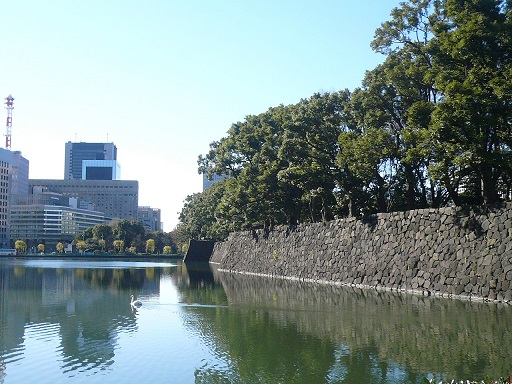
|
"Babasaki" Moat
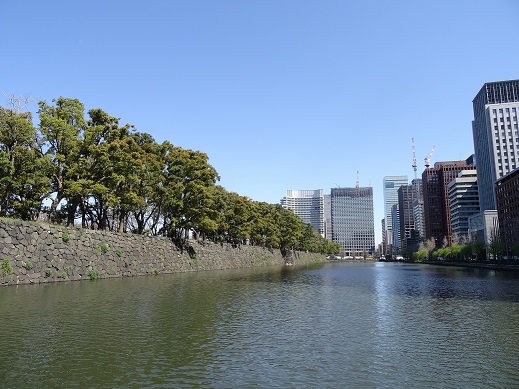
|
|
These moats are middle moats of Edo Castle. Beyond these moats, there are pine trees on the widely spread grass field. This is Palace Plaza.
At the Edo Age
(1603 - 1868)
, retainers houses were located at the current Palace Plaza.
The statue of KUSUNOKI Masashige
(1294? - 1336)
is located in the south-east corner of the Palace Plaza.
He is well known as the admiral who was very loyal and supported the Emperor.
To the north of the Palace Plaza, two original turrets remain along the inner moat.
|
"Kikyo-Mon" Gate and the Gate Turret
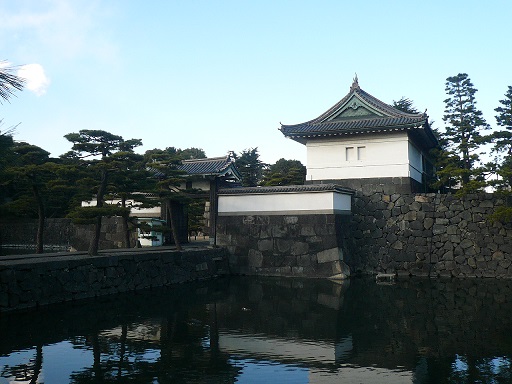
|
"Sakurada" Turret
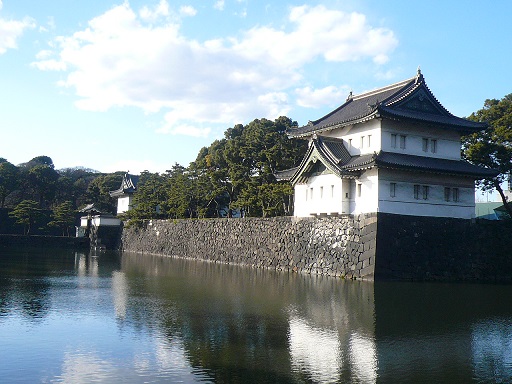
|
|
To the east towards the Marunouchi Area, you will see modern office buildings.
The contrast of historical turrets and modern buildings is very impressive.
In Japan, especially in big cities, buildings are close together.
Contrary, very wide open scenery can be seen from Palace Plaza.
If you walk to south from the "Kikyo-Mon" Gate,
you will see "Sakashita-Mon" Gate and then you will see the view of "Fushimi" Turret and "Nijyubashi" Bridge. "Sakasita-Mon" Gate is the main gate to the Imperial Palace and the Imperial Household Agency.
If you are lucky, you will see a parade of a carriage.
This parade is to transport guests of the Emperor between Tokyo Station and the
Imperial Palace.
|
The Parade of Carriage

|
Fushimi Turret and "Nijyubashi" Bridge
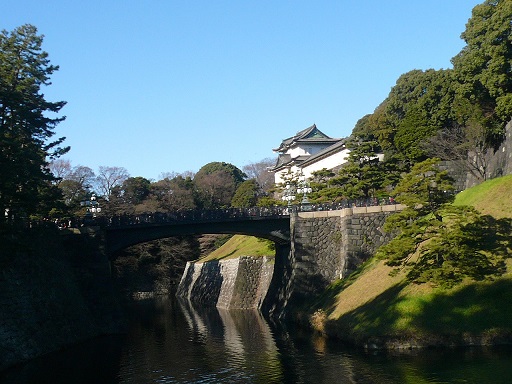
|
|
The view of the "Fushimi" Turret and the "Nijyubashi" Bridge is one of similar representative views in Japan.
On the second day of the new year and the birthday of the Emperor, the Imperial Palace is open to the public. People can visit the Imperial Palace by going through the "Nijyubashi" Bridge.
For more details, please visit the page of the Imperial Palace:
http://handejapan19.html.xdomain.jp/TravelDestinations/Kanto/ImperialPalace_E.html
Further south from the Palace Plaza, you will arrive at the "Soto-Sakurada-Mon" Gate.
The "Soto-Sakurada-Mon" Gate is protecting the main area of the Edo Castle and it is surrounded by the "Sakurada" Moat and the "Gaisen" Moat.
The "Soto-Sakurada-Mon" Gate was originally built in 1637 and is designated as an important property of Japan.
On March 24, 1860, II Naosuke, the chief minister of the government, was assassinated outside of the gate. At the end of the Edo age, especially after Japan was forced to open the country in 1854, all Japan became in a state of rebellion. The power of "Edo Bakufu", the government of Japan, lost their power. That is the brief background of the assassination.
Approximately 160 years have passed since II Naosuke was assassinated, Japan is in peace and it is very difficult to imagine such tragic assassination happened in this place.
From the "Soto-Sakurada-Mon" Gate, you can walk to the west along the "Sakurada" Moat.
The combination of blue of the wide moat and green of the grass of the bank is very impressive.
|
|
Along the moat, you will go up the slop toward the "Hanzo-Mon" Gate. You will see the "Sakurada" Moat far below your feet. You can also see the government buildings beyond the moat.
I think this view is one of the most spectacular views in Tokyo. You will soon arrive at the "Hanzo-Mon" Gate, The gate is named after HATTORI Hanzo, who was the leader of "Ninjya" and served for TOKUGAWA Ieyasu
(1543 - 1616)
.
The gate was closed and strictly guarded by police.
|
|
"Chidorigahuchi" Moat
The "Chidorigahuchi" Moat is located to the north of the main bailey of Edo Castle, and is well known for the beautiful cherry blossoms in Spring. In this section, Edo Castle from the "Hanzo-Mon" Gate to the "Chidorigahuchi" Moat through the "Inui" Moat and the north bailey is introduced.
To the eastside of the main area of Edo Castle, the "Hanzo-Mon" Gate is located. The gate and the earth-paved bridge is shown in the below picture.
From the "Hanzo-Mon" Gate, you can walk north along the "Hanzo" Moat. Then, walk to the "Kitahane-Bashi-Mon" Gate to the east. On the way, you will see the "Inui-Mon" Gate on your right. The Gate building was originally used as the back gate of the west bailey, located near "Sakashita-Mon" Gate, and moved to the current location in 1888.
During the Edo Age
(1603 - 1868)
, prefects of the Edo Castle lived in this place.
|
|
The "Inui-Mon" Gate is usually closed, but especially open when the Imperial Palace is open to the public in spring and late autumn.
After 15 to 20 minutes of walking from the "Hanzo-Mon" Gate, you will arrive at the "Kitahane-Bashi-Mon" Gate. The "Kitahane-Bashi-Mon" Gate was the back gate of Edo Castle. Very steep stone walls of the main bailey and the earth-paved bridge to the "Kitahane-Bashi-Mon" Gate indicate how the gate was firmly protected against enemies.
To the north of the "KItahane-Bashi-Mon" Gate, the north bailey was located during the Edo Age. The site of the north bailey is now open to the public as the north bailey park.
In the north bailey, houses of three privileged branches of TOKUGAWA Family were located. These three families were HITTSUBASHI, TAYASU and SHIMIZU families. To the east side of the north bailey, the "Shimizu-Mon" Gate is located.
The "Shimizu-Mon" Gate has the square-shaped area of land with the combination of a smaller gate, called a "Korai-Mon" Gate and a larger one, a "Yagura-Mon" Gate.
|
|
To the north of the "Shimizu-Mon" Gate, "Nippon Budokan" is located. "Nippon Budokan" is a gymnasium to conduct Japanese "Budo" tournaments, like "Jyudo", "Karate" and "Kendo", etc. Music concerts are also held at the "Budokan". In 1966, the Beatles played their concerts here.
To the north of "Nippon Budokan", the "Tayasu-Mon" Gate is located. It is unknown when the "Tayasu-Mon" Gate was built, but it is said that it was built at the beginning of the 17th century.
|
|
If you go out of the north bailey through the "Tayasu-Mon" Gate, you will see the "Ushigahuchi" Moat on your right.
In spring, beautiful cherry blossoms bloom along the moat.
On your left, "Chudorugahuchi" Moat is located out of the north bailey.
The "Chidorigahuchi" Moat is located to the west of the north bailey.
Chidorigahuchi" Moat is very well-known for cherry blossoms.
In April, couples enjoyed taking a boat ride at the "Chidorigahuchi" Moat.
The scenery was very peaceful.
|
Cherry Blossoms at "Chidorigahuchi" Moat
|
|
|
|
|
During the season of cherry blossoms, many people come to enjoy them at the "Chidorigahuchi" Moat.
I think the cherry blossoms at the "Chidorigahuchi" are one of the best cherry blossoms in Japan.
|
|


 Home Page in Japanese: "Shane's HomePage"
Home Page in Japanese: "Shane's HomePage"


 Home Page in Japanese: "Shane's HomePage"
Home Page in Japanese: "Shane's HomePage"